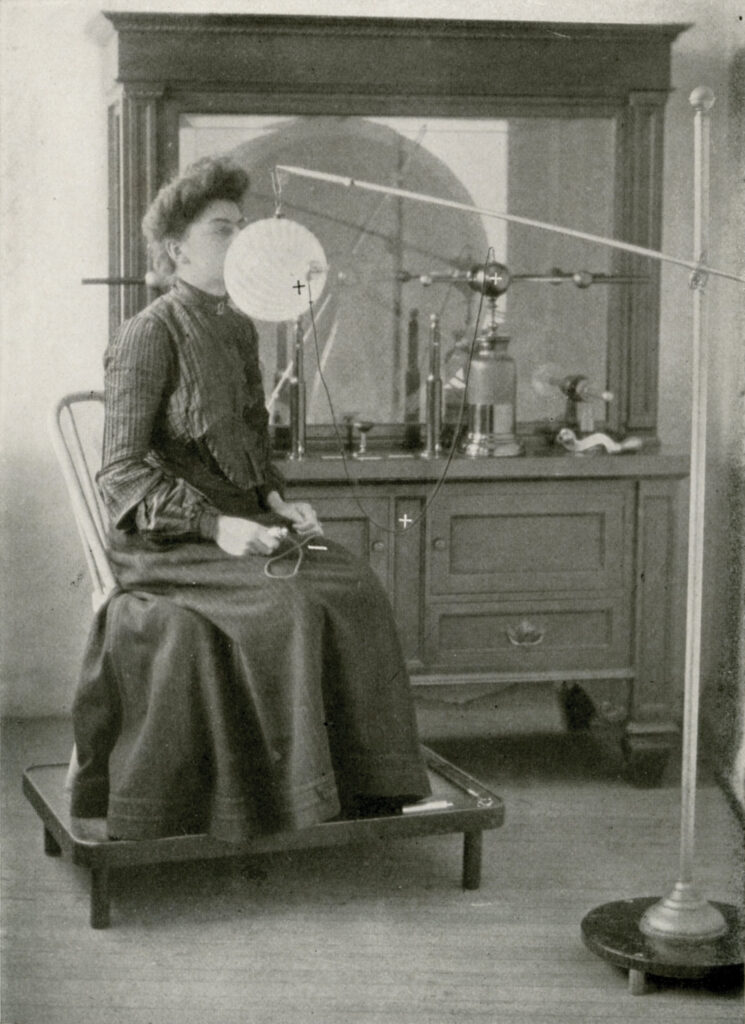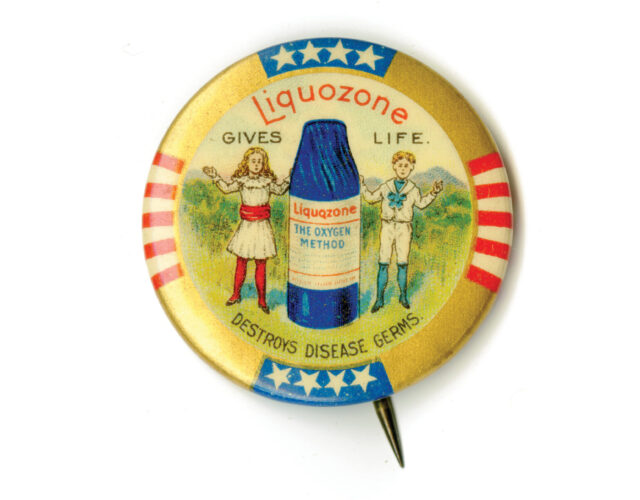In 1903 Nikola Tesla was growing desperate. The prodigious inventor had wooed the multimillionaire J. P. Morgan to invest in wireless electric power, but so far Tesla’s attempts to create the technology had proven fruitless.
When Morgan refused to continue backing the project, Tesla implored the banker to reconsider:
Morgan’s response was simple: no.
Tesla, his credibility tarnished by his faltering venture, needed to restore his reputation and generate cash. He admitted as much to Morgan: “It is absolutely imperative for me to put out something commercial without delay.” So Tesla turned to another of his inventions. In 1896 he had patented the first portable ozone generator in the United States. After Morgan’s rejection the cash-strapped scientist incorporated the Tesla Ozone Company, pitching his devices as a way to clean indoor air.
In the late 1800s city dwellers increasingly worried about the “smoke evil,” which was produced by the burning of vast amounts of coal and believed to cause illness. During this time pollution—a word previously reserved by Noah Webster for “unclean” carnal acts, such as nocturnal emissions—came to mean the human dirtying of air and water. Urbanites could do little about the dirty air outside their homes, but perhaps they could breathe more easily inside.
In fact, Tesla’s machines filled rooms with poison: ozone in the upper atmosphere provides an important shield against the sun’s ultraviolet light, but pump it into your living room and it will harm you.
Today the FDA declares ozone a toxic gas with no known therapeutic purposes; ozone generators have been approved only for sterilizing water and equipment. Yet unscrupulous merchants peddle ozone as a cure for cancer and AIDS. An Internet search of “ozone therapy” shows that ozone use is alive and well—in air purifiers, in topical ointments, and in gas blown into the rectum.
How did ozone, long known to be toxic, ever develop a health-giving reputation?
Before humans discovered ozone, they smelled it. The German-Swiss scientist Christian Friedrich Schönbein noticed a distinct odor after directing an electric current through water. In 1840 he suggested that the electricity was creating a new substance, which he dubbed ozone—from ozein, Greek for “to smell.” (Schönbein was right: when charged with electricity, oxygen forms an unstable molecule of three oxygen atoms. This molecule, ozone, is also produced when lightning strikes the air, creating the same smell Schönbein detected in the lab.)
From the beginning ozone beguiled the imagination of medical professionals and entrepreneurs. For one thing it smells “clean.” When water droplets break up in air—as during a lightning storm—ozone is created along with a “fresh” smell associated with rainfall.
Ozone’s smell propelled interest in its purifying properties, even as experiments revealed its harmful effects. In 1874 chemist James Dewar and a colleague reported that after exposure to ozonized air, frogs grew lethargic, birds gasped for breath, and rabbits’ blood lost oxygen. A respondent in Nature, while acknowledging that Dewar’s experiments revealed a risk for overexposure, continued to endorse the use of ozone in hospitals, based on a traditional belief that lightning—and therefore ozone—cleared the air. In addition some ozone enthusiasts believed (and still believe) the molecule can better provide the body with the oxygen it needs because it is composed of three oxygen atoms rather than the more usual two.
Yet even ozone’s discoverer recognized its harmful effects. Schönbein reported that inhaling ozone could cause chest pains and breathing difficulty. Mice subjected to an atmosphere of ozone died.

Nonetheless, ozone’s healthful aura persisted. In 1911, one year after the Tesla Ozone Company incorporated, an article in the Proceedings of the Royal Society of London B marveled that ozone’s healthful effects “have, by mere iteration, become part and parcel of common belief; and yet exact physiological evidence in favour of its good effects has been hitherto almost entirely wanting.” The authors found the only clear consequences of ozone to be lung damage and death. Yet they still accepted ozone’s positive potential, speculating that the molecule’s beneficial effects worked through smell.
There was a whiff of truth in the conjectures swirling around ozone; its three-oxygen-atom structure is unstable, and as it breaks down, it peels away electrons from cell walls and destroys the cell’s DNA. That destructive property makes ozone useful in disinfecting water and, in some cases, dental and medical tools. But the havoc that ozone wreaks on bacterial cells applies to human tissue as well, making it dangerous to apply to skin in amounts sufficient to, say, clean wounds.
During World War I, nurses and doctors used ozone for just that purpose. The medical community seemed willing to try a range of disinfection methods to treat the growing number of wounded troops who filled hospitals. Doctors at Queen Alexandra’s Military Hospital in London used ozone to treat wounds and abscesses, applying the gas directly to injuries for up to 15 minutes or until the flesh was “glazed.”
The U.S. Army Medical Department included ozone as a “chief method” for disinfecting war wounds in its surgical history of World War I, and at least one nursing manual from the time referred to a German method of cleaning wounded flesh with ozone. But a review of surgical techniques that the U.S. Army produced after the war emphasized other sanitizing techniques, such as sodium hypochlorite antiseptics.
In fact, irrigating wounds with antiseptics, which became popular after World War I, may have caused ozone’s popularity to dwindle. Medical handbooks began to address ozone therapy with skepticism. A nursing handbook from 1919 refers to “popular fallacies” about ozone, suggesting that its beneficial effects were less certain than its poisonous ones. By the 1950s the FDA had begun seizing ozone generators.
But ozone generators never completely went away. And ozone’s promise has evolved to match the claims of modern charlatans. With the plethora of other cheap and effective disinfectants on the market, ozone peddlers are less inclined to stress their product’s sanitizing qualities. Curing infertility, HIV-AIDS, and cancer is the new pitch. This metamorphosis is as much a result of human desperation as of marketing savvy.
Sites selling ozone products almost invariably use history to emphasize their credibility, highlighting Tesla’s involvement and ozone’s medicinal use during World War I. These sites frequently mimic academic citations by including other pro-ozone URLs, creating tangles of cyber citations that lead nowhere.
Vendors balance these attempts at scientific credibility with generous doses of vagueness. For example, one site promises “influence on cellular membranes and balancing of the levels of lipid peroxidation products.” That string of words may sound pretty scientific, but it’s just another way of describing ozone’s ability to indiscriminately infiltrate cell membranes and kill cells—hardly a desirable effect.
The complicated jargon is matched with ozone’s seductive simplicity—a chemical compound of the middle school–science variety. It’s a combination that is hard to resist since shoppers are more drawn to what they think they understand.
In 2010 the FDA seized 77 ozone generators in California slated to be sold as medical devices for an approximate total of $80,000. Though the FDA doesn’t collect data on who buys the devices, anecdotal evidence suggests some alternative-medicine doctors purchase ozone generators for their clinics, charging patients hundreds or thousands of dollars for the promise of a cure. In cases that have attracted media attention patients have died after receiving ozone therapy rather than other, more standard treatments. In a 2015 case two Las Vegas homeopathic doctors allegedly used ozone generators to fill a syringe with ozonized solution and inject it into a patient, who died in the process. The doctors were charged with second-degree murder and faced a minimum 25 years in prison.
For the most part federal responses to ozone therapy have been muted. The FDA has not sent a warning letter to a generator manufacturer since 2012. The Federal Trade Commission (FTC), which has jurisdiction over false advertising claims, brought its most recent ozone-related action in 2000 against a Tennessee-based manufacturer of ozone generators. The case settled for about $1.5 million and barred the manufacturer from making future claims about the devices’ ability to purify air. “It’s primarily a resource issue for us,” said Richard Cleland, assistant director of the FTC’s Division of Advertising Practices. Unable to pursue every false advertising claim made, the FTC has to evaluate the health and monetary risks posed by an advertisement before proceeding with a case. Cleland believes ozone ads are targeting a relatively small audience of homeopathy enthusiasts. “I’m not sure how much the sales are for these companies,” he says. In short the FTC has bigger fish to fry.
Tesla, though no mean showman himself, would probably be surprised to learn that today’s ozone peddlers use his brief involvement as an imprimatur of legitimacy. When it comes to his ozone generators, Tesla seems to have been free from delusions of grandeur. Ozone is not mentioned in his self-promotional autobiography My Inventions.
Tesla told Morgan he would create a philosophers’ stone from his wireless technology—an endless source of wealth. But he may have underestimated ozone. It has become its own kind of philosophers’ stone. Through grand promises and chemical mystique, ozone therapy continues to transmute a base substance into gold.




